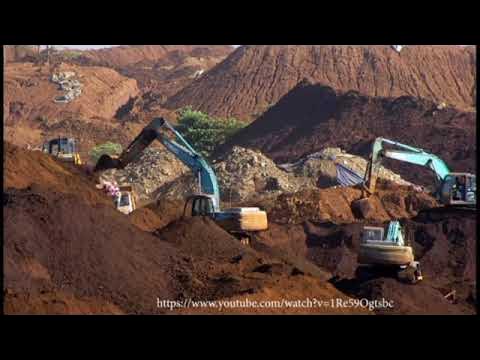Planetary boundaries crossed — Delikado na nga bang mabuhay sa Mundo? | Need To Know
Summary
TLDRThe transcript discusses the environmental challenges facing the world today, including the impact of industries like mining, coal plants, and agriculture on the planet's livability. Issues such as water wastage, deforestation, and pollution from plastics and chemicals are highlighted. The speaker emphasizes the importance of transitioning to more natural farming methods and notes the positive effects of banning chlorofluorocarbons on the ozone layer. However, the current situation remains dire, with increasing risks to human health and the environment from pollutants like vehicle emissions and industrial chemicals.
Takeaways
- 😀 Human activities are pushing environmental boundaries, potentially making the world less livable than before.
- 😀 Major industries, such as mining and coal plants, contribute significantly to environmental degradation, with agriculture being the largest contributor.
- 😀 A lot of water is wasted, both by private distributors and through leaks in pipes and dams.
- 😀 Only 60% of the world remains forested, a concerning figure based on the criteria of sustainability.
- 😀 Plastic pollution is a major issue, as plastics made from fossil fuel hydrocarbons are widespread and difficult to manage.
- 😀 A shift toward more natural, less chemical-intensive farming practices could be a simple yet challenging solution.
- 😀 The ban on chlorofluorocarbons (CFCs) about 20 years ago helped improve the ozone layer.
- 😀 Pollution in urban areas, such as Manila, exposes people to harmful particles from vehicles and burning, which is damaging to health.
- 😀 The environment today poses greater risks and threats to human health compared to the past.
- 😀 Despite some improvements, the situation remains critical, with growing environmental challenges threatening human well-being.
Q & A
What happens when the livable limits of the world are surpassed?
-When the livable limits of the world are surpassed, the environment will change to a point where it may no longer be as bright or livable for humans. This could result in detrimental changes to the quality of life on Earth.
Which industries contribute the most to environmental damage, according to the script?
-The mining industry, coal plants, and agriculture are highlighted as the biggest contributors to environmental damage. Agriculture, in particular, is a significant factor due to water wastage.
What is the issue with water wastage as mentioned in the script?
-Water wastage occurs both in private water distribution systems and through leaks in pipes, which results in a large loss of available water.
What percentage of the world remains forested, and why is this important?
-According to the study referenced in the transcript, only 60% of the world is still forested. This is important because forests play a crucial role in maintaining the balance of life on Earth.
How are plastics related to environmental issues discussed in the script?
-Plastics, made from fossil fuel hydrocarbons, contribute significantly to environmental pollution. The study indicates that an abundance of plastics and other synthetic chemicals are present in the environment, posing serious ecological risks.
What is the proposed solution for reducing chemical-based farming?
-The proposed solution is to return to more natural farming practices that reduce the use of chemicals, thereby improving environmental sustainability.
What role did the ban on chlorofluorocarbons (CFCs) play in improving the ozone layer?
-The ban on chlorofluorocarbons (CFCs), which was implemented around 20 years ago, played a significant role in improving the ozone layer by eliminating one of its primary pollutants.
What are the risks of inhaling pollution from vehicles, as mentioned in the script?
-Inhaling pollutants from vehicles, such as exhaust fumes and particulate matter, is harmful to the lungs and can lead to various respiratory problems.
How has the environment become more dangerous for humans, according to the script?
-The environment has become more dangerous for humans due to increased risks from pollution, climate change, and the proliferation of harmful chemicals, which have made the surroundings more hazardous.
What is the overall outlook for the environment based on the information presented in the transcript?
-The outlook for the environment is concerning, with rising threats from pollution, water scarcity, and climate change. The current trajectory indicates that living conditions may become increasingly challenging for humans.
Outlines

Dieser Bereich ist nur für Premium-Benutzer verfügbar. Bitte führen Sie ein Upgrade durch, um auf diesen Abschnitt zuzugreifen.
Upgrade durchführenMindmap

Dieser Bereich ist nur für Premium-Benutzer verfügbar. Bitte führen Sie ein Upgrade durch, um auf diesen Abschnitt zuzugreifen.
Upgrade durchführenKeywords

Dieser Bereich ist nur für Premium-Benutzer verfügbar. Bitte führen Sie ein Upgrade durch, um auf diesen Abschnitt zuzugreifen.
Upgrade durchführenHighlights

Dieser Bereich ist nur für Premium-Benutzer verfügbar. Bitte führen Sie ein Upgrade durch, um auf diesen Abschnitt zuzugreifen.
Upgrade durchführenTranscripts

Dieser Bereich ist nur für Premium-Benutzer verfügbar. Bitte führen Sie ein Upgrade durch, um auf diesen Abschnitt zuzugreifen.
Upgrade durchführenWeitere ähnliche Videos ansehen

Proses Singkat Pengolahan Batubara Menjadi Energi Listrik dan Pembersihan Gas Buangnya

VIDEO RISET 03

Harga Batu Bara Panas-Dingin, Emiten Pelayaran Diversifikasi Bisnis

Lavra em Tiras

Documentário: Neoextrativismo na América Latina: resistências e alternativas

Documentary on COAL: Mining, History and Future Outlook
5.0 / 5 (0 votes)
